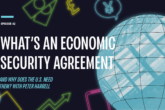December 31, 2024
Goodbye to Small Yard, High Fence
On Dec. 2, the United States announced a new round of export controls on advanced semiconductors to China, and more restrictions are expected soon. It was among the final pieces in an enduring legacy of the Biden administration: a significant expansion in the scale and scope of restricting China’s access to technology.
To explain this policy over the past two years, including this month’s announcement, the administration repeatedly turned to one metaphor: a small yard with a high fence. It means that sensitive technologies should be kept within a yard protected by a high fence of trade and investment controls. But the yard should be small, limited to a narrow set of advanced technologies with military applications, while broader commercial trade and investment with China would continue.
Will Mr. Trump’s more confrontational approach work better?
As the Biden administration enters its final days, the contradictions of this “small yard, high fence” strategy are piling up. It is an attempt to achieve two goals that are inherently in conflict — pursuing a fundamental shift in the geopolitics of technology competition without upending the global economic order. The administration is falling short on both of these objectives. When Donald Trump takes office, his foreign policy team is likely to take the technology control tools that the Biden team developed but was reluctant to employ broadly and to unleash them at full force, resulting in significant economic disruption. So much for that manicured small yard.
The idea behind the “small yard, high fence” strategy made sense at first and reflected the Biden administration’s attempt to balance competing pressures in its relationship with China: the need to maintain, as the national security adviser, Jake Sullivan, put it, “as large of a lead as possible” over its primary strategic rival in foundational technology without severing all meaningful economic links.
Read the full article on The New York Times.
More from CNAS
-
Economic Security in North America
Executive Summary In its request for comment, the Office of the U.S. Trade Representative (USTR) solicits comments on and recommendations for “specific actions [to promote] al...
By Emily Kilcrease & Geoffrey Gertz
-
How Sanctions Became a Way to Wage War and When They Actually Work, with Eddie Fishman
In this episode of “Financial Crime Matters,“ Kieran Beer talks with Eddie Fishman, CNAS adjunct senior fellow and author of “Chokepoints: How the Global Economy Became a Weap...
By Edward Fishman
-
Defense / Energy, Economics & Security / Technology & National Security
The Outlook CEO Perspectives on Risk, Resilience and ReturnsJoin David Schwimmer and Richard Fontaine, CEO of the Center for New American Security, as they explore the current national security landscape and its impacts on global econo...
By Richard Fontaine
-
What's an Economic Security Agreement and Why Does the U.S. Need Them? With Peter Harrell
Derisky Business is returning for season 2! After a brief hiatus in which obviously nothing (nothing!) notable happened in the world of trade and economic security, Emily and ...
By Geoffrey Gertz & Emily Kilcrease





As the Biden administration introduced a series of new trade and investment controls to curtail China’s acquisition of advanced technologies, it has repeatedly turned to a familiar metaphor: a small yard with a high fence. In a new Guest Essay for the New York Times, Geoffrey Gertz assesses the contradictions and limitations of this strategy to limit access to certain sensitive technologies without upending the broader U.S-China economic relationship. With the Trump administration preparing to return to power, it is likely to abandon the constraints of a “small yard” and deploy the toolkit the Biden team developed at full force, resulting in significant economic disruption.